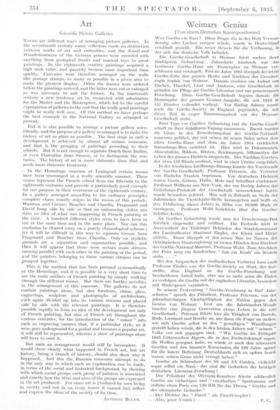Art
Scientific Picture Galleries THERE are different ways of arranging picture galleries. In the seventeenth century many collectors, made no distinction between works of art and curiosities, and the Kunst-und IV underkammern of the German princes were crowded with anything from geological freaks and musical toys to great ,paintings. In the eighteenth century paintings acquired a high snob value, and quantity became more important than ,quality. Canvases were, therefore arranged on the walls like postage stamps, as many as possible in a given area to make the greatest display. Often the frames were ordered before the paintings arrived, and the latter were cut or enlarged as was necessary to suit the former. In the nineteenth century , a new tendency set in, connected with, admiration for the Master and the Masterpiece, which led to the careful expurgation of galleries to the end that the really good paintings might be really well seen. Of this method we have perhaps the best example in the National Gallery as arranged at present.
But it is also possible to arrange a picture gallery scien- tifically, andAbe purpose of a gallery so arranged is to make the .,,history of art as plain as possible.. The first, stage in such a development is ,achieved by almoSt .. all serious museums, and that is the grouping of, paintings according to their 6c.h6ols. But it is not enough to separate Dutch from Italian, or even Florentine from Sienese, ,or to distinguish the cen- turies... The history of art is more elaborate than that and needs more elaborate treatment.
In .the Hermitage museum at Leningrad certain rooms have been rearranged in a really scientific manner. These looms represent the French school from the fifteenth to the eighteenth centuries and provide a particularly good example for our purpose in their treatment of the eighteenth century. .tIn a gallery arranged according to the ordinary principles complete chaos usually.reigns in the rooms of this periods. Watteau and Greuze, Boucher and Chardin, Fragonard and David hang side by side so that an unknowing visitor can form no idea of what was happening in French painting. at the time. A hundred different styles seem to have been in use at the same time and in the same place. Nor can this confusion be cleared away on a purely chronological scheme ; for it will be difficult in this way to separate Greuze from Fragonard and Boucher from Chardin. Only on stylistic grounds arc a separation and organisation possible, and then it will appear that there were certain main streams running parallel with each other in the painting of the period, • a-ll the painters belonging to these various streams can be grouped together.
This is the method that has been pursued systematically at the Hermitage, and it is possible in a very short time to see the main outlines of French painting by simply walking through the different rooms. But there are further novelties in the arrangement of this museum. The galleries do not• contain paintings alone, but also furniture, china, glass, engravings, sculpture and photographs of architecture, each again divided up into its various streams and placed 'Side by 'sidewith' the relevant paintings. It is therefore • poSsible rapidly to form an idea of the development not only of "French painting, .Init als6. of French art throughout the various centuries, fOr-the introduction of the " minor " 'arts such as ,engraving ensures that, if a particular style, as it were, goes underground for a period and becomes a popular art, ' it will still be represented, whereas a show of paintings alone will have. to omit it.
But such an arrangement would still be incomplete. It would show clearly what happened in French art, . but art history, being a branch of history, should also show why it happened. And this the Russian museums attempt to do in the only way in which such an explanation, can be made, in terms of the social and historical background, by showing with :which social groups each.group of painters is associated and exactly how the ideas and aims of the groups are expressed in the art produced. For since art is produced by men living in society and not in an. ivory tower it cannot but, reflect and express the ideas of the society of its, time.
AN'THONY BLUNT.






































 Previous page
Previous page